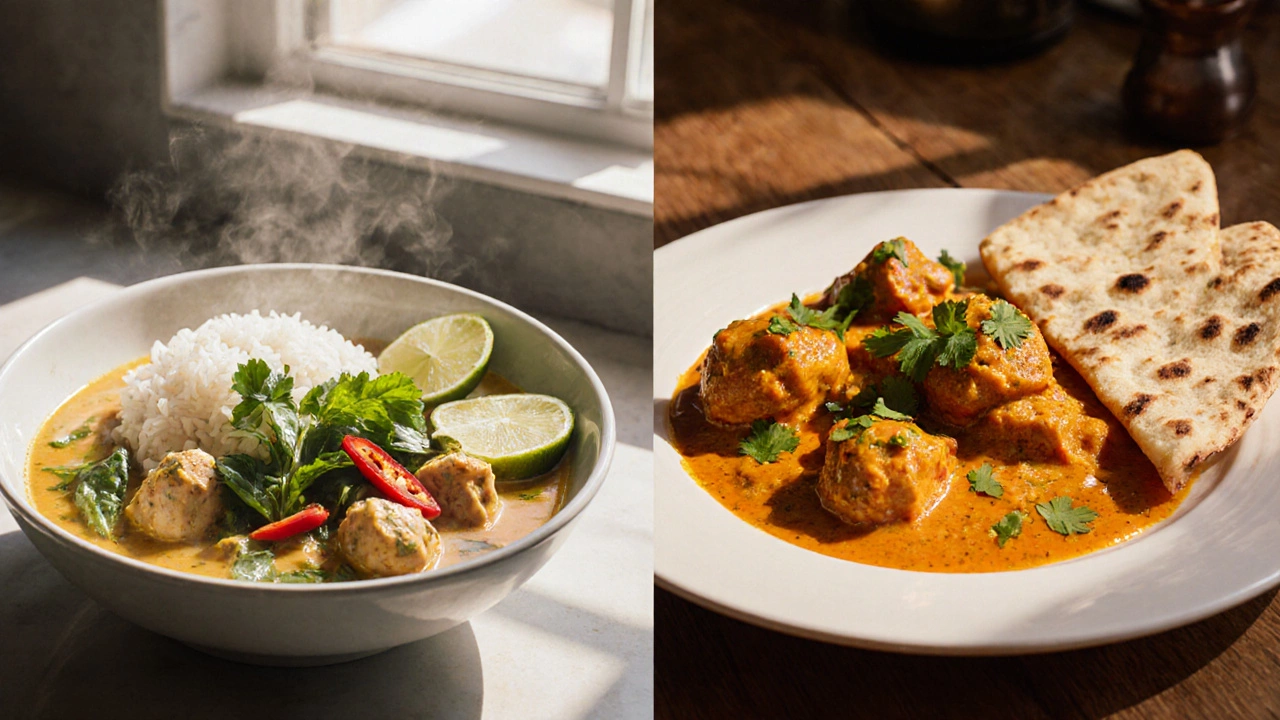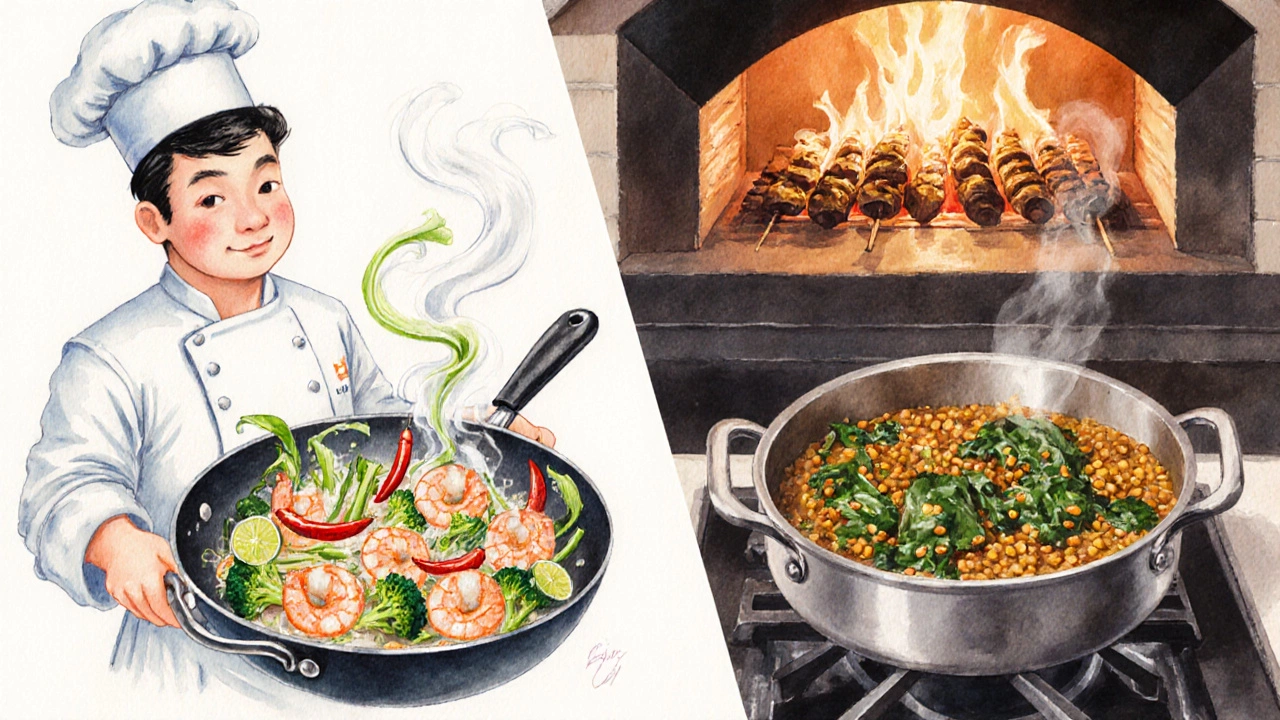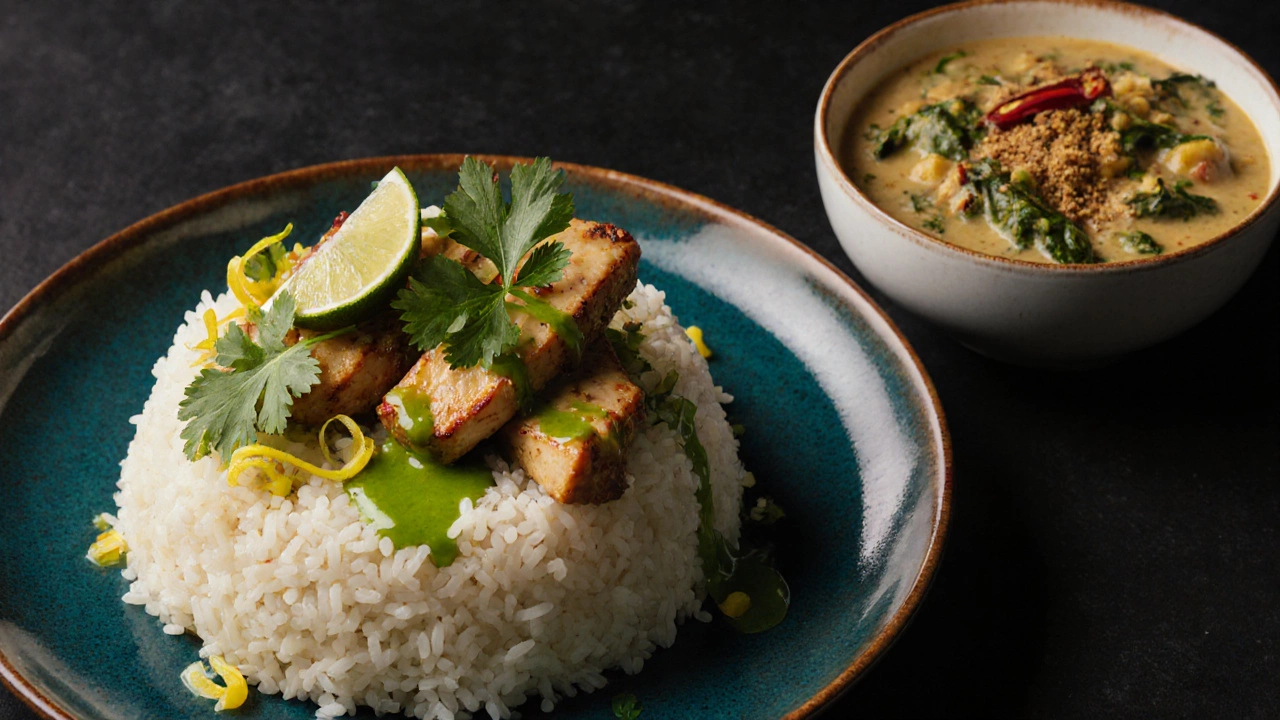Thai vs Indian Food: Which Is Healthier?
 Oct, 16 2025
Oct, 16 2025
Thai vs Indian Food Calorie Calculator
Compare calories between Thai and Indian dishes using data from the article. Based on 155 kcal/100g for Thai dishes and 210 kcal/100g for Indian dishes.
When you picture Asian flavors, two cuisines dominate the conversation: Thai food is a fresh, aromatic cuisine that leans heavily on herbs, chilies, lime, and coconut milk and Indian food is a spice‑rich culinary tradition that ranges from buttery curries to tandoori grills. Both are beloved worldwide, but which one helps you stay healthier? Below we break down the nutrients, cooking habits, and typical ingredient choices so you can decide which fits your wellness goals.
What Makes Thai Cuisine “Light”?
Thai dishes often start with a balance of sweet, sour, salty, and spicy flavors. The core ingredients include:
- Fresh herbs (basil, cilantro, mint)
- Lime juice and zest
- Chilies (bird’s eye, jalapeño)
- Coconut milk (used sparingly in soups and curries)
- Lean proteins such as shrimp, chicken breast, or tofu
- Whole grain or rice noodles, jasmine rice, and sometimes cauliflower rice
These components keep the overall calorie load moderate. A typical serving of TomYum soup has about 150kcal, thanks to the broth base and a handful of mushrooms. The high water content of vegetables (bokchoy, bean sprouts) adds volume without extra calories.
Key Ingredients in Indian Cuisine
Indian cooking spans a massive geographic area, but a few ingredients appear in most households:
- Ghee or oil (mustard, sunflower, coconut)
- Whole spices (cumin, coriander, fenugreek, cardamom)
- Legumes (lentils, chickpeas, kidney beans)
- Paneer (fresh cheese) and dairy‑based sauces
- Rice (basmati, brown) and wheat‑based breads (chapati, naan)
- Vegetables (eggplant, okra, spinach) cooked in gravy
Because many recipes rely on a base of sautéed onions, ginger, garlic, and tomatoes cooked in oil, the fat content can climb quickly. A single serving of butter chicken can exceed 400kcal, mainly from ghee and cream.
Calorie & Macro Comparison
| Metric | Thai Dish (e.g., Green Curry with Chicken) | Indian Dish (e.g., Chicken Tikka Masala) |
|---|---|---|
| Calories | 155kcal | 210kcal |
| Protein | 12g | 13g |
| Fat | 7g (mostly unsaturated from coconut) | 11g (including saturated from ghee) |
| Carbohydrates | 14g (mainly from vegetables) | 16g (including sauce sugars) |
| Fiber | 3g | 2g |
| Sodium | 420mg | 660mg |
Even though both dishes deliver similar protein, Thai meals generally provide fewer calories, less saturated fat, and more fiber thanks to the higher vegetable ratio.
Vitamins, Antioxidants, and Phytonutrients
Thai cuisine shines with herbs like lemongrass, kaffir lime, and Thai basil, each packed with vitaminC and flavonoids that combat oxidative stress. Chili peppers introduce capsaicin, a compound linked to metabolism boosting and pain relief.
Indian food balances the antioxidant load through turmeric (curcumin), cumin, and coriander. Turmeric, in particular, has been studied for its anti‑inflammatory properties. However, the bioavailability of curcumin spikes only when paired with black pepper and a bit of fat - the same fat that can raise calorie counts.
Overall, both cuisines supply a robust micronutrient profile; the deciding factor is how much of those nutrients survive the cooking process. Quick stir‑fries (Thai) preserve more vitaminC than slow‑cooked gravies (Indian), where heat can degrade some heat‑sensitive vitamins.

Sodium, Sugar, and Saturated Fat
Sodium is a hidden culprit in many Indian sauces, especially when commercial spice blends or canned tomato puree are used. A study from the Indian Council of Medical Research found average Indian restaurant meals contain 1.5‑2times the WHO’s recommended sodium limit.
Thai street food often adds fish sauce, which is salty, but portion sizes are smaller, and chefs balance it with lime and herbs. If you control the sauce amount, Thai dishes can stay under 500mg sodium per serving.
Sugar appears more in Indian sweets and some chutneys, while Thai desserts (like mango sticky rice) are usually served as a separate course, making it easier to moderate overall intake.
Cooking Techniques and Their Health Impact
- Stir‑frying (Thai) - uses high heat for a short time, preserving nutrients and keeping oil usage low.
- Steaming (Thai) - ideal for fish and vegetables, virtually calorie‑free.
- Deep‑frying (both) - popular for samosas or fish cakes; adds significant fat.
- Slow‑cooking/ simmering (Indian) - develops deep flavor but often requires more oil and butter.
- Tandoor grilling (Indian) - high‑heat dry cooking that can reduce fat if excess oil is trimmed.
Choosing techniques like stir‑fry, grill, or steam helps keep both cuisines in the healthy lane.
Practical Tips to Make Each Cuisine Healthier
- Swap coconut milk for low‑fat coconut water or a splash of almond milk in Thai curries.
- Use extra‑virgin olive oil or avocado oil instead of ghee for Indian sauté bases.
- Load up on fresh veggies - add broccoli, bell peppers, or snow peas to any curry.
- Control portion sizes of rice; try cauliflower rice for Thai dishes or brown basmati for Indian meals.
- Season with herbs and spices rather than extra salt; lemon or lime juice adds brightness without sodium.
- Incorporate legumes (dal, chickpeas) as protein sources to cut down on saturated fat.
These swaps keep flavor while shaving off 100‑200kcal per serving.

Quick Health‑Focused Recipes
Thai‑Style Lemongrass Chicken Stir‑Fry
- 150g skinless chicken breast, thinly sliced
- 1 stalk lemongrass, finely minced
- 1cup broccoli florets
- ½cup sliced carrots
- 1tsp fish sauce
- Juice of ½ lime
- 1tsp sesame oil (for flavor, not cooking)
- Fresh cilantro for garnish
Heat a non‑stick wok, add a splash of water, toss in lemongrass, then chicken. Once cooked, add veggies, fish sauce, and lime juice. Serve over a small scoop of cauliflower rice. Approx. 280kcal.
Indian‑Inspired Lentil & Spinach Curry (Daal Palak)
- ½cup red lentils, rinsed
- 2cups fresh spinach, roughly chopped
- 1tsp cumin seeds
- ¼tsp turmeric
- 1tsp ginger‑garlic paste
- 1tsp mustard oil (use sparingly)
- Pinch of salt, black pepper
Cook lentils until soft. In a separate pan, temper cumin in mustard oil, add ginger‑garlic paste, turmeric, and spinach. Combine with lentils, simmer 5minutes. Serves 2, ~210kcal per portion.
Bottom Line: Which Is the Better Choice?
If you prioritize low calories, lower saturated fat, and higher fiber, Thai cuisine generally has the edge-provided you keep an eye on coconut milk and fish sauce quantities. Indian food offers powerful anti‑inflammatory spices and great plant‑based protein options, but many classic recipes rely on ghee, cream, and higher sodium.
Ultimately, the healthiest path is to blend the best of both worlds: use the fresh herbs and quick‑cook methods of Thai cooking while borrowing the nutrient‑dense legumes and spices of Indian meals. Tailor portion sizes, choose lean proteins, and favor steaming or stir‑frying, and you’ll enjoy robust flavors without compromising your wellness goals.
Frequently Asked Questions
Is coconut milk in Thai food unhealthy?
Coconut milk is high in saturated fat, but a typical Thai serving uses only ¼‑½ cup. Swapping half the milk for low‑fat coconut water cuts calories while keeping the creamy texture.
Can I make Indian dishes low‑fat without losing flavor?
Yes. Replace ghee with a teaspoon of olive oil, use yogurt instead of cream, and finish dishes with fresh herbs or a squeeze of lemon to boost taste.
Which cuisine is better for heart health?
Both can support heart health if prepared mindfully. Thai’s reliance on herbs and lean proteins keeps cholesterol low, while Indian spices like turmeric and cumin have documented anti‑inflammatory benefits. The key is to limit added saturated fats and sodium.
How many calories are typical in a Thai versus Indian meal?
A standard Thai entree (e.g., green curry with chicken) averages 150‑200kcal per 100g, whereas a comparable Indian main (e.g., butter chicken) ranges 200‑250kcal. Portion size and sauce amount are the biggest variables.
Are Thai salads healthier than Indian salads?
Thai salads often feature raw veggies, herbs, and a light lime‑fish‑sauce dressing, keeping calories low. Indian salads can be richer, with yogurt‑based dressings or fried toppings. Choose the Thai style for a lighter option.